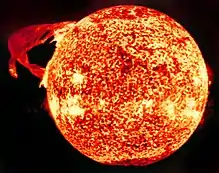Interface Region Imaging Spectrograph
The Interface Region Imaging Spectrograph (IRIS),[2] also called Explorer 94,[3] is a NASA solar observation satellite. The mission was funded through the Small Explorer program to investigate the physical conditions of the solar limb, particularly the chromosphere of the Sun. The spacecraft consists of a satellite bus and spectrometer built by the Lockheed Martin Solar and Astrophysics Laboratory (LMSAL), and a telescope provided by the Smithsonian Astrophysical Observatory. IRIS is operated by LMSAL and NASA's Ames Research Center.
.jpg.webp) The Interface Region Imaging Spectrograph | |
| Names | Explorer 94 |
|---|---|
| Mission type | Heliophysics |
| Operator | NASA |
| COSPAR ID | 2013-033A |
| SATCAT no. | 39197 |
| Mission duration | Planned: 2 years Elapsed: 7 years, 7 months, 4 days |
| Spacecraft properties | |
| Manufacturer | Lockheed Martin |
| Launch mass | 183 kg (403 lb) |
| Start of mission | |
| Launch date | 28 June 2013, 02:27:46 UTC |
| Rocket | Pegasus-XL F42 |
| Launch site | Stargazer, Vandenberg |
| Contractor | Orbital Sciences |
| Orbital parameters | |
| Reference system | Geocentric |
| Regime | Sun-synchronous |
| Semi-major axis | 7,015.38 km (4,359.16 mi) |
| Eccentricity | 0.0029478 |
| Perigee altitude | 623 km (387 mi) |
| Apogee altitude | 665 km (413 mi) |
| Inclination | 97.90 degrees |
| Period | 97.47 minutes |
| Epoch | 24 January 2015, 02:50:49 UTC[1] |
The satellite's instrument is a high-frame-rate ultraviolet imaging spectrometer, providing one image per second at 0.3 arcsecond angular resolution and sub-ångström spectral resolution.
NASA announced on 19 June 2009 that IRIS was selected from six Small Explorer mission candidates for further study,[4] along with the Gravity and Extreme Magnetism (GEMS) space observatory.[5]
The spacecraft arrived at Vandenberg Air Force Base, California, on 16 April 2013[6] and was successfully launched on 27 June 2013 by a Pegasus-XL rocket.[7]
Science results
IRIS achieved first light on 17 July 2013.[8] NASA noted that "IRIS's first images showed a multitude of thin, fibril-like structures that have never been seen before, revealing enormous contrasts in density and temperature occur throughout this region even between neighboring loops that are only a few hundred miles apart."[8] On 31 October 2013, calibrated IRIS data and images were released on the project website.[9] A preprint describing the satellite and initial data has been released on arXiv.[10]
Data collected from the IRIS spacecraft has shown that the interface region of the sun is significantly more complex than previously known. This includes features described as solar heat bombs, high-speed plasma jets, nano-flares, and mini-tornadoes. These features are an important step in understanding the transfer of heat to the corona.[11]
In 2019 IRIS detected tadpole like jets coming out from the Sun according to NASA.[12]
IRIS team
Science and engineering team members include:[9]
- Lockheed Martin Solar and Astrophysics Lab
- Lockheed Martin Sensing and Exploration Systems
- Smithsonian Astrophysical Observatory
- Montana State University
- Institute for Theoretical Astrophysics, University of Oslo
- High Altitude Observatory, National Center for Atmospheric Research
- Stanford University
- NASA Ames Research Center
- NASA Goddard Space Flight Center
- National Solar Observatory
- Space Sciences Laboratory, University of California, Berkeley
- Princeton Plasma Physics Laboratory
- Sydney Institute for Astronomy, University of Sydney
- Center for Plasma Astrophysics, Catholic University of Leuven
- Mullard Space Science Laboratory
- Rutherford Appleton Laboratory
- European Space Agency
- Max Planck Institute for Solar System Research
- National Astronomical Observatory of Japan
- Niels Bohr Institute, University of Copenhagen
References
- "IRIS Satellite details 2013-033A NORAD 39197". N2YO. 24 January 2015. Retrieved 25 January 2015.
- "Interface Region Imaging Spectrograph (IRIS)". NASA Space Science Data Coordinated Archive. 2013. 2013-033A.
- "NASA's Explorer Program Satellites". NASA Space Science Data Coordinated Archive. 2014.
- Harrington, J. D. (29 May 2008). "NASA Selects Small Explorer Investigations for Concept Studies". NASA.gov.
- Harrington, J. D. (19 June 2009). "NASA Awards Two Small Explorer Development Contracts". NASA.gov.
- Hendrix, Susan; Diller, George (17 April 2013). "NASA'S Newest Solar Satellite Arrives at Vandenberg AFB for Launch". NASA.gov.
- "IRIS Solar Observatory Launches, Begins Mission". NASA.gov. 28 June 2013.
- Fox, Karen C. (25 July 2013). "NASA's IRIS Telescope Offers First Glimpse of Sun's Mysterious Atmosphere". NASA.gov. Retrieved 29 July 2013.
- "Interface Region Imaging Spectrograph". Lockheed Martin Solar and Astrophysics Laboratory.
- De Pontieu, B.; Title, A. M.; Lemen, J.; Kushner, G. D.; Akin, D. J.; et al. (July 2014). "The Interface Region Imaging Spectrograph (IRIS)". Solar Physics. 289 (7): 2733–2779. arXiv:1401.2491. Bibcode:2014SoPh..289.2733D. doi:10.1007/s11207-014-0485-y.
- De Pontieu, B.; Rouppe van der Voort, L.; McIntosh, S. W.; Pereira, T. M. D.; Carlsson, M.; et al. (October 2014). "On the prevalence of small-scale twist in the solar chromosphere and transition region". Science. 346 (6207): 1255732. arXiv:1410.6862. Bibcode:2014Sci...346D.315D. doi:10.1126/science.1255732. PMID 25324398.
- Garner, Rob (19 February 2019). "Tadpole-Like Jets From Sun Add New Clue to Age-Old Mystery". NASA. Retrieved 10 April 2019.
External links
| Wikimedia Commons has media related to IRIS (satellite). |
- IRIS website by NASA
- IRIS website by NASA Goddard Space Flight Center
- IRIS website by Lockheed Martin
.png.webp)





